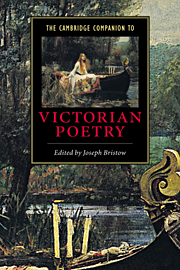Book contents
- Frontmatter
- 1 Reforming Victorian poetry: poetics after 1832
- 2 “The Lady of Shalott” and the critical fortunes of Victorian Poetry
- 3 Experimental form in Victorian poetry
- 4 The dramatic monologue
- 5 Victorian meters
- 6 Victorian poetry and historicism
- 7 Victorian poetry and science
- 8 Victorian poetry and religious diversity
- 9 The Victorian poetess
- 10 The poetry of Victorian masculinities
- 11 Aesthetic and Decadent poetry
- 12 Victorian poetry and patriotism
- 13 Voices of authority, voices of subversion: poetry in the late nineteenth century
- Glossary
- Guide to Further Reading
- Index
10 - The poetry of Victorian masculinities
Published online by Cambridge University Press: 28 May 2006
- Frontmatter
- 1 Reforming Victorian poetry: poetics after 1832
- 2 “The Lady of Shalott” and the critical fortunes of Victorian Poetry
- 3 Experimental form in Victorian poetry
- 4 The dramatic monologue
- 5 Victorian meters
- 6 Victorian poetry and historicism
- 7 Victorian poetry and science
- 8 Victorian poetry and religious diversity
- 9 The Victorian poetess
- 10 The poetry of Victorian masculinities
- 11 Aesthetic and Decadent poetry
- 12 Victorian poetry and patriotism
- 13 Voices of authority, voices of subversion: poetry in the late nineteenth century
- Glossary
- Guide to Further Reading
- Index
Summary
Representations of masculinity - what men should think and feel, how they should look, and what sorts of work they should do - shifted several times in Victorian England. During the first half of the nineteenth century, as Herbert Sussman demonstrates in Victorian Masculinities: Manhood and Masculine Poetics in Early Victorian England (1995), a discourse about manliness was constructed in response to industrialization and changes in the socioeconomic class system. The traditional distinction between upper class landowning aristocracy versus lower-class unpropertied laborers was complicated by the rise of a middle class of industrialists, bankers, merchants, and a variety of professionals. Historians Leonore Davidoff and Catherine Hall point to the “delineation of gender difference” as one of the main features of the Victorian middle class. In particular, the balance between brawn and brains in the paradigm of masculinity was transformed. Manhood now involved work that might be more mental than physical. Rigorous moral as well as economic self-discipline became the hallmark of masculinity and the basis of claims to cultural authority, according to James Eli Adams in Dandies and Desert Saints: Styles of Victorian Masculinity (1995). For example, the early Victorian sage Thomas Carlyle defined manliness in terms of strenuous effort, both in the workplace and in the soul. His On Heroes, Hero-Worship, and the Heroic in History (1840) became a guidebook for several generations of Victorian men seeking a firm gender identity.
- Type
- Chapter
- Information
- The Cambridge Companion to Victorian Poetry , pp. 203 - 227Publisher: Cambridge University PressPrint publication year: 2000
- 1
- Cited by



